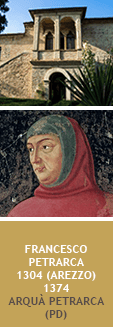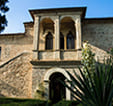The House of Petrarca at Arquà (Padova)
"In the Euganean Hills, I had a small house built, seemly and noble; here, I live out the last years of my life peacefully, recalling and embracing with constant memory my absent or deceased friends". (Petrarca, Senili, XIII, 8, letter to Matteo Longo, January 6 1371).
In 1369, Francesco Petrarca (Arezzo, 1304, Arquà, 1374), tired of his continual peregrinations, and by now old and ill, had one of the houses in the Euganean village of Arquà adapted to his requirements, and elected to live in it for the rest of his days. Here, he was surrounded by old and new friends and by the members of his family: his daughter Francesca, his son-in-law Francescuolo da Brossano, and his grand-daughter Eletta.
Here too, he continued to attend to his studies. And it was here that he died, his head resting on his beloved books, in the night of July 18-19, 1374.
The story of the house
Petrarca's house was perhaps given to him by Francesco I da Carrara, a lord of Padova and one of his good friends. Petrarca decided to restore it, suiting it to his purposes and personally following the building alterations. He had the two sections of which the original house was composed joined together, and had the upper floor of the left-hand building (seen from the front) turned into a residence for himself and his family. The right-hand building, slightly higher, which also contained the main entrance, housed the servants' quarters and was also used for other domestic purposes. There was a garden in front and a kitchen-garden behind. Petrarca devoted considerable attention to caring for his plants, although he was not always successful.
Inside the house, the poet changed the arrangement of the rooms: in his part of the building, the central room became a hall in which to welcome visitors, a function to which it was suited, since it had a large window giving on to the garden and was closed by a fireplace towards the kitchen-garden. The left-hand room was divided into two, in order to create a small study. The windows were recreated in Gothic style, and two balconies and three fireplaces were added. After Petrarca's death, the house had several owners, but the building itself was not changed in any material way, in order to respect the memory of the poet. Quite soon, it came to be considered as the setting for Petrarca's memories and was a place of literary and sentimental pilgrimage.
In the mid-Cinquecento, the new owner Paolo Valdezocco made some changes to some of the rooms, adding the small loggia and the outside staircase, which is still used to reach the first floor. He also had the walls decorated with frescoes inspired by Petrarca's works, paintings which may still be admired.
The house later changed hands many times, but remained more or less as it was in Petrarca's time, and was subsequently transformed into a museum, in memory of the Poet.
The last private owner, Cardinal Pietro Silvestri, left the house in 1875 to the City of Padova, which officially entered into possession on February 6 1876.
Ground floor
Petrarca's cat.
In an ornate Baroque frame, Petrarca's faithful cat still vigilates, motionless. According to tradition, these are the embalmed remains of the poet's pet.
In fact, this is an invention by Girolamo Gabrielli, owner of the house in the early 17th century.
Until the 1970s, the cat was kept in the poet's apartments, above the entrance to the study in the Room of Venus, also called the "Cat's Room", and has always been one of the best-known curiosities of the house.
Central room, also called Room of the Metamorphoses
The frieze of this room shows seven scenes taken from the allegories of Petrarca's canzone Nel dolce tempo della prima etade, the XXIII from the Canzoniere, also known as the Canzone delle metamorfosi (Song of the Metamorphoses).
This scenes start from the far corner of the left wall, opposite the entrance (the poet as a laurel tree), continue along the right-hand wall, and end with the figure of an eagle, opposite the entrance. On each side of the eagle are depicted an altar with a fire which neither wind nor rain can extinguish (nec vento nec imbre) and a five-pointed star, symbol of health or, perhaps, of a knot which cannot be unbound.
Venus' room
This room, called "The Venus' room" as the painting on the chimney-breast, perhaps in the beginning was the Petrarca's bedroom. The decorative frieze on the upper part of the walls, above the motifs in false brocade with clusters of pomegranates, is in such poor condition that it is difficult to make out the scenes depicted. On the wall to the left of the entrance is a ship; on the wall leading to the study, a group of men by a small pond (left) and a spring (right).
On the nearby wall is Petrarca, sitting near a stream, with a book in his hand, and a woman with a child in front of him.
It is very likely to refer to the canzone Qual più diversa et nova, the CXXXV from the Canzoniere.
This room was also called the "Cat's Room". Until the seventies, above the entrance to the study a self held the embalmed remains of Petrarca's cat which at present lie on the ground floor.
Petrarca's study
It is believed that this small dark room was used by Petrarca as a study, a place for work and meditation, in which he kept his precious and well-loved books, and where he died in the night between July 18 and 19 1374.
The walls still show traces of the original 14th-century decoration: coloured bands with a frieze beneath, composed of a recurrent coat-of-arms alternating with swags of flowers from which false red and green curtains hang. The study holds the chair, old bookcase and cupboard which, according to long-standing tradition, were used by Petrarca.
The Room of the Visions
This well-preserved frieze shows scenes from Petrarca's canzone Standomi un giorno solo a la fenestra, the CCCXXIII from the Canzoniere, called Canzone delle visioni (Song of the Visions). The frieze starts on the left with the fine portrait of Petrarca, painted above the entrance to the small room on the left, similar to his bronze head in the central room.
Cleopatra's Room, also known as the African Room or Lucretia's Room
Known as Cleopatra's Room, because of the painting of Cleopatra on the chimney-breast, this room is also called the African Room, or Lucretia's Room. The former name derives from the series of paintings, unfortunately considerably damaged, shown in the upper frieze recalling "Africa", one of Petrarca's Latin poems, celebrating the feats of Scipio the African. The latter name derives from the fine 16th-century stucco relief (set in the niche above the entrance to the room on the right), showing the Roman heroine Lucretia as she lies dying. On the chimney-breast, above the figure of Cleopatra bitten by the asp, is the Greek poetess Sappho, writing in her study, and as she throws herself from the cliff of Levkas. There are also two other paintings on each sides.








